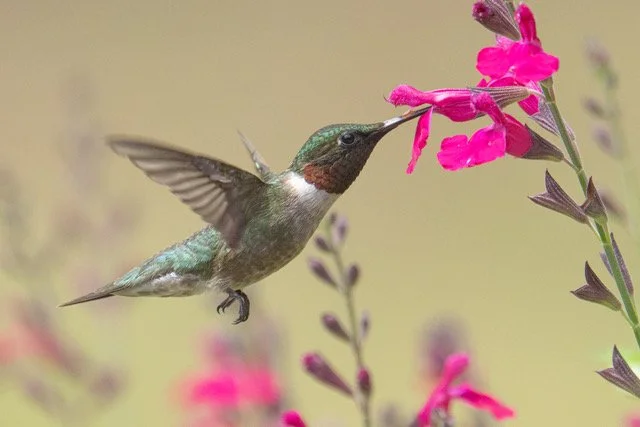All about hummingbirds
By MARY ELIADES, HSV Voice correspondent
FIRST PUBLISHED IN THE APRIL 23, 2024, ISSUE OF THE HOT SPRINGS VILLAGE VOICE. REPRINTED WITH PERMISSION.
Hummingbirds are very popular visitors to Hot Springs Village, as evidenced by the full house at the Coronado Center auditorium when Tana Beasley gave her recent presentation – “What’s to Love about Hummingbirds?” – to HSV Audubon members and guests. Beasley presented information about hummingbird habitat, behavior, banding, etc., and answered many questions from audience members afterward.
Audubon president Norma Wall introduced Beasley as “the hummingbird expert of Arkansas,” and Beasley is the only person in the state with a valid federal master bird banding permit for hummingbirds.
Beasley emphasized again and again that hummingbirds are attracted to the color red. Most hummingbird feeders have red “flowers” or other pieces and she said there was no need to color the nectar – in fact, red dye may be harmful to the birds. Beasley also said, “I hope you’re making your own nectar – one part sugar to 4 parts water.”
Hummers visit 400 to 500 flowers per day (individual flowers, not plants), and have “beyond ultraviolet vision,” according to Beasley. They can spot feeders and flowers from a long distance, and are attracted to many plants that grow easily in the Village: Carolina jasmine, red buckeye, honeysuckle, salvia coccinea, lantana, jewel weed (which can also be used to negate the effects of poison ivy and mosquito bites), cardinal flower, bee balm (grows quickly and produces many flowers), crocosmia lucifer, and mimosa trees. Beasley said hummingbird mothers use the “soft, fuzzy stuff” from mimosa trees in their nests to protect the “naked” babies. She suggested, however, that people wanting to attract the little birds should “give one [mimosa plant] to your neighbor” – they’re beautiful, “but love to take over.”
Hummingbirds get their energy from nectar and have long beaks perfectly suited to the task. They can hover and move in any direction, which makes them fascinating to watch. The birds can tell if a flower has already been “harvested” and will move on to the next one without stopping. But hummingbirds “don’t exist on nectar alone,” said Beasley. They need protein and supplement their diet with tiny insects, spiders, etc.
They also love water and enjoy a shallow birdbath or flying through a sprinkler.
Hummingbirds are attracted to anything red – buildings, furniture, clothing, etc. – and even a red patio chair near a feeder will lure the creatures in. Beasley said if a hummingbird gets into a house or garage, the best strategy is to let it fly around for a while (to tire it out) and then put something red out for it to land on. They can then be easily – but carefully – caught.
The female hummer weighs about the same as a nickel and a male around the same as a penny. Males have forked tails and red gorgets; females have blunt tails with white at the tips and shorter beaks. A baby hummingbird is about the size of a bumblebee.
Beasley is an expert bander, and gave a thorough, illustrated description of the banding process. A bird is caught for banding by putting a feeder inside a cage and shutting the door after it flies in. Beasley said the birds don’t seem to mind being held for the time it takes to attach a band, which is only 5.6 millimeters long.
The birds have relatively short lives, mainly due to predators – cats, other birds, snakes, frogs, dragonflies, praying mantises, etc. The average lifespan is four to six years – too often “they are food for other critters.” The nests are always well hidden.
Hummingbirds do not mate for life. Beasley said, “The males are showoffs,” and do not help with nest duties. In fact, the females chase them away from the nest because their bright colors can attract predators.
Hummers usually lay two eggs, twice in a season. Beasley said the birds leave the nest about 21 days after hatching; before they take off, they “practice” by holding on to the nest with their legs and “working” their wings. One nestling usually hatches about nine days before the second one.
In June or July, the birds “know when to go,” but Beasley recommends leaving feeders out for the stragglers.
Hummingbirds may go up to Canado or the East Coast of the United States and then make their way down to Central America or Mexico for the winter. They can make the 20- to 21-hour flight over the Gulf without stopping or eating. The rufous hummingbird sometimes overwinters in Arkansas and hosts can put a shop light 12 to 14 inches away from the feeder to keep the nectar from freezing.
Next month, HSV Audubon will welcome Virginia McDaniel from the U.S. Forest Service, who will discuss glades in the Village. For more information, visit hsvbirds.org.

